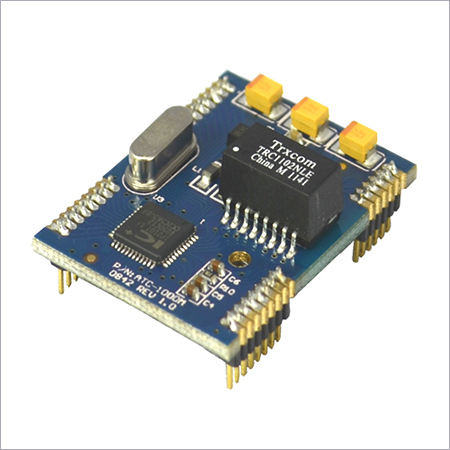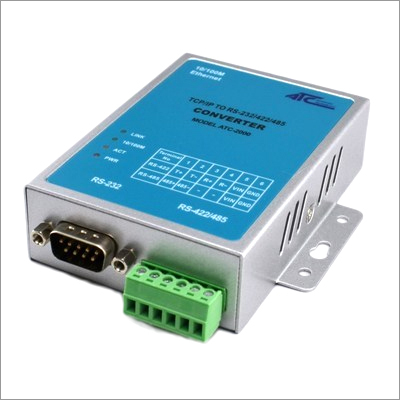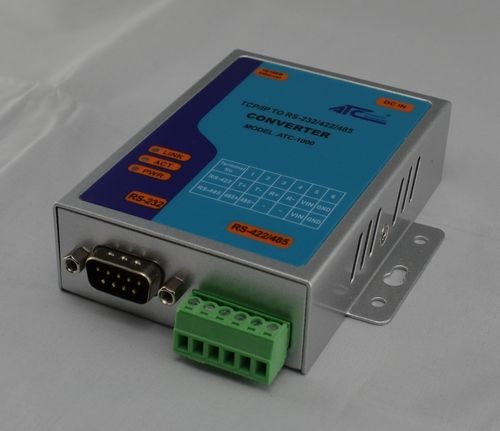
ATC-1000M Serial To Ethernet Embedded Module
Price 1600.00 INR/ Box
ATC-1000M Serial To Ethernet Embedded Module Specification
- Product Type
- Serial To Ethernet Embedded Module
- Number of Channels
- 1
- Call Control Protocol
- TCP/IP, UDP, ARP, ICMP, HTTP, DHCP, DNS, SNMP
- Frequency (MHz)
- 50/60 MHz
- Storage Temperature
- -40C to +85C
- Network Connection Methods
- Ethernet 10/100 Mbps Adaptive
- Power
- 3.3V DC, 150mA
- Dimension (L*W*H)
- 53 mm 30 mm 13 mm
- Weight
- Approx. 22 g
- Power Supply
- 3.3V DC
- Size
- Compact
- Led Indicator
- Power, Serial Tx/Rx, Ethernet Link/Act
- Usage
- Serial device networking
- Range
- 100 meters (Ethernet cable limit)
- Material
- Metal Shell
- No. of Ports/Pins
- 2 Ports (1 x Serial, 1 x Ethernet), 10-pin header
- Color
- Blue
- Height
- 13 mm
ATC-1000M Serial To Ethernet Embedded Module Trade Information
- Minimum Order Quantity
- 1 , , Box
- Supply Ability
- 100 Boxes Per Week
- Delivery Time
- 7 Days
About ATC-1000M Serial To Ethernet Embedded Module
ATC-1000M
- AddsEthernetconnectivityforRS-232/422/485devices
- 10/100MbpsEthernet;230,400bpsserialdatarate
- SupportsTCP/Server,TCP/ClientandUDPmode
- ProvidessixTTL-levelprogrammabledigitalI/Os
- Web/Telnet/Serialconsolesfordeviceconfiguration
- Windowsutilityincludedfordevicemanagement
FormFactor
- Type :30-pindual-inlinedrop-inmodule
- Pitch :1.27mm
- Dimensions :37x27x12mm
NetworkInterface
- Type :10/100BaseT,auto-detect
- Protocols :TCP,UDP,HTTP,Telnet,IP,ICMP,ARP
- IPaddressing :DHCP,StaticIP
OperationModes
- TCP/Server,TCP/ClientandUDPmode
- SerialInterface(TTL-level)
- Signals :TxD,RxD,RTS,CTS,DTR,DSR,DCD,GND
- Baud :300to230,400bps
- Parity :None,Even,Odd
- Databits :7,8
- Stopbit :1,2
- Flowcontrol :None,RTS/CTS,XON/OFF
- ProgrammableDigitalI/O
- PIO0PIO6 :TTLlevelcompatible
- ConfigurationMethods
- Webconsole,TelnetConsoleandSerialConsole
- Windowsutility(includedinCD)
General
- Powerinput:3.3VDC
- Powerconsumption:350mA@+3.3VDC
- Operationtemp.:070C,595%RH
- Storagetemp.:-2085C,595%RH
- Regulation:CE/FCCcompliant
Versatile Serial Interface and Configuration
The ATC-1000M offers adaptable serial communication with either RS232/TTL or RS485 (user-configurable) for maximum flexibility. Settings such as baud rate, data bits, stop bits, and parity can be tailored to your application needs. Multiple configuration methodsincluding via web server, AT commands, serial, or networkstreamline the setup process for rapid deployment.
Robust Network Protocol and Protection
Supporting a wide array of network protocols such as TCP, UDP, DHCP, HTTP, and more, this module assures seamless integration into diverse networking environments. Its built-in EMC protection circuits, metal shell, and industrial-grade design offer durable and safe performance even in demanding conditions.
Compact Design with Effortless Monitoring
The modules petite dimensions (53 mm 30 mm 13 mm) allow it to be embedded directly onto PCBs, facilitating efficient use of space in industrial enclosures. Integrated LED indicators provide real-time status for power, data transmission, and network link, aiding troubleshooting and maintenance.
FAQs of ATC-1000M Serial To Ethernet Embedded Module:
Q: How do I configure the ATC-1000M module for my application?
A: Configuration can be carried out through the built-in web server, using AT commands, via serial port, or over the network. This enables adaptation to different system requirements and simplifies both initial setup and subsequent adjustments.Q: What serial interfaces does the ATC-1000M support and how can these be selected?
A: The module supports RS232/TTL and RS485 interfaces, which are selectable through configuration. This allows you to connect to a variety of serial devices depending on your applications specific communication protocol.Q: When is a remote firmware upgrade possible for the ATC-1000M?
A: Remote firmware upgrades are supported at any time, providing the module maintains network connectivity. This feature helps you keep the device updated without physically accessing the hardware.Q: Where can the ATC-1000M be mounted and what are the environmental limits?
A: The module is designed for PCB embedding and compact enclosures. It operates reliably between -40C to +85C and in humidity environments of 5% to 95% RH (non-condensing), making it suitable for harsh industrial settings.Q: What process should be followed to connect a device to Ethernet using the ATC-1000M?
A: Connect your serial device to the modules serial port and link the Ethernet interface to your network. Configure the communication parameters and network settings using the provided methods. Once setup, the module enables network data exchange for your serial device.Q: What are the main benefits of using the ATC-1000M Serial To Ethernet Embedded Module?
A: This module simplifies serial device networking with robust protocol support, flexible configuration, secure operation, and compact size. Its industrial-grade durability and remote management capabilities deliver reliability and facilitate long-term maintenance efficiency.

Price:
- 50
- 100
- 200
- 250
- 500
- 1000+
More Products in Serial to TCP/IP(ETHERNET) Converter Category
ATC 2000 Serial To TCP/IP Converter
Price 8200 INR / Piece
Minimum Order Quantity : 1 Piece
Power Supply : External adapter (DC 924V)
Size : Standard
Storage Temperature : 40C to 85C
Usage : Other, Connect serial devices to Ethernet networks
ATC 1200 Serial To TCP/IP Ethernet Converter
Price 3800.00 INR / Piece
Minimum Order Quantity : 200
Power Supply : External DC Adapter
Size : Standard Module
Storage Temperature : 20C to +85C
Usage : Other, Converts RS232/RS485 serial data to TCP/IP Ethernet
RS232/RS422/RS485 to TCP/IP Converter
Price 16500.00 INR / Box
Minimum Order Quantity : 200
Power Supply : External adapter, DC input
Size : Standard
Storage Temperature : 40C to +85C
Usage : Other, Industrial device networking, remote serial communication
TCP/IP to 4-Port RS232/RS422/RS485 Converter
Price 22000 INR
Minimum Order Quantity : 1 , , Box
Power Supply : 5V DC Adapter
Size : Standard (185 x 110 x 30 mm)
Storage Temperature : 40 to +85
Usage : Other, Industrial Automation, Remote Device Control
 |
MICON AUTOMATION SYSTEMS PVT. LTD.
All Rights Reserved.(Terms of Use) Developed and Managed by Infocom Network Private Limited. |
 Call Me Free
Call Me Free
 English
English Spanish
Spanish French
French German
German Italian
Italian Chinese (Simplified)
Chinese (Simplified) Japanese
Japanese Korean
Korean Arabic
Arabic Portuguese
Portuguese Send Inquiry
Send Inquiry




 Call Me Free
Call Me Free